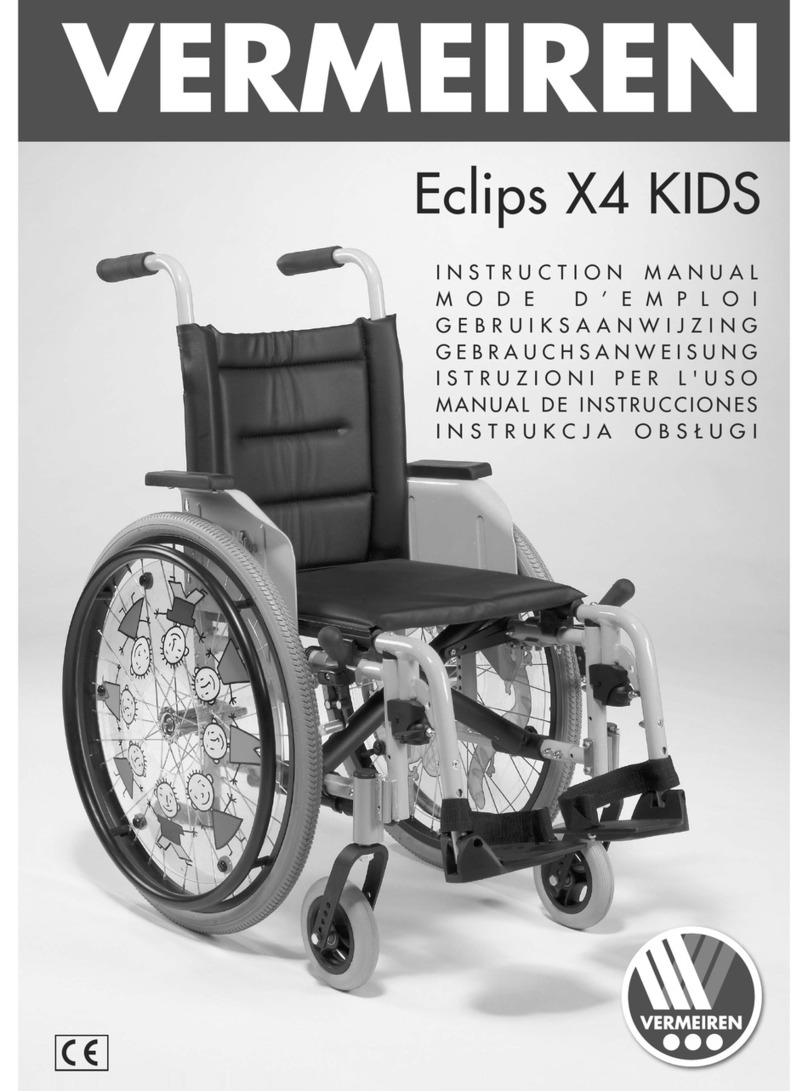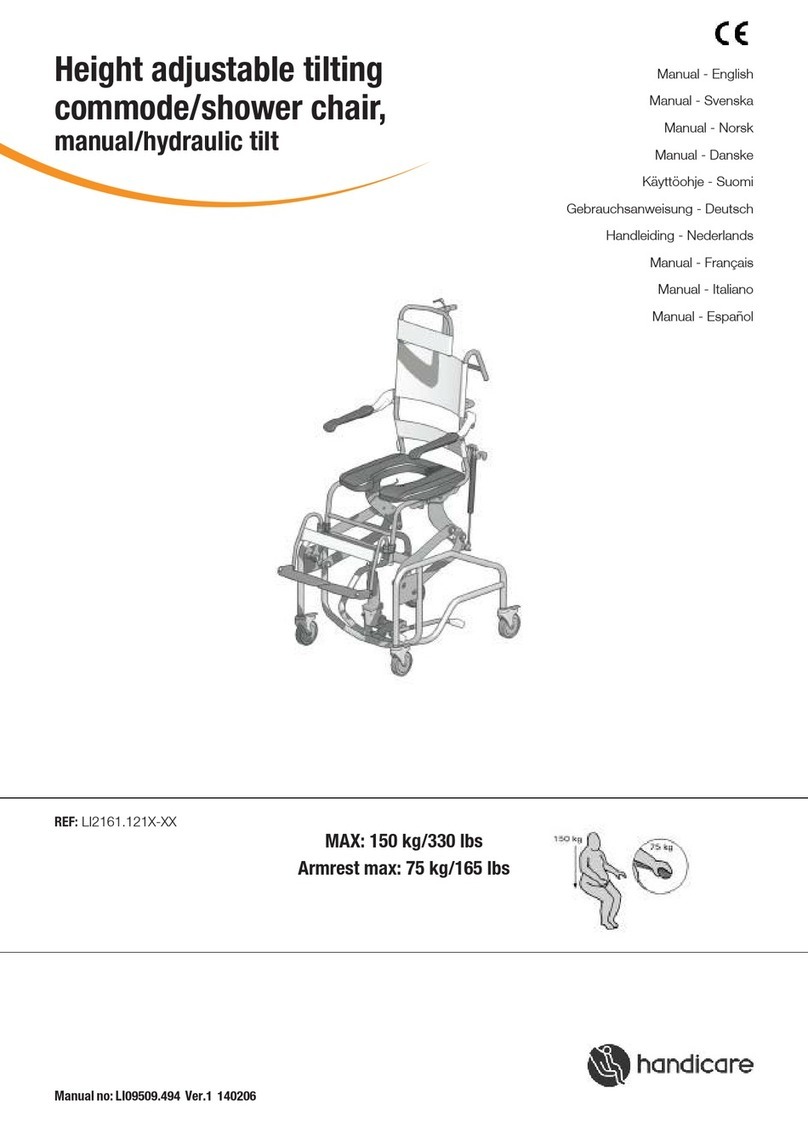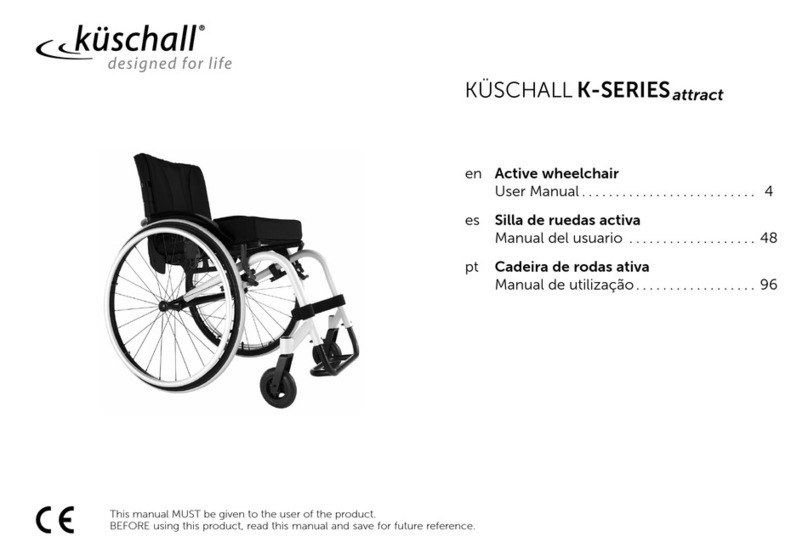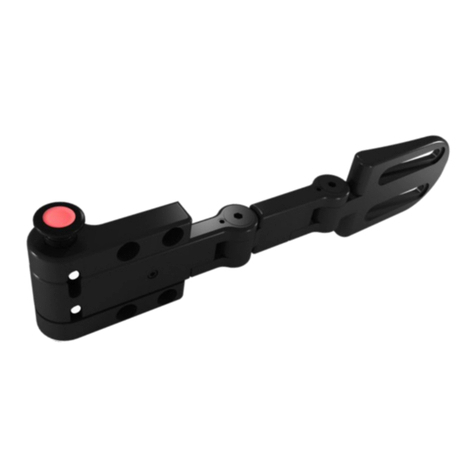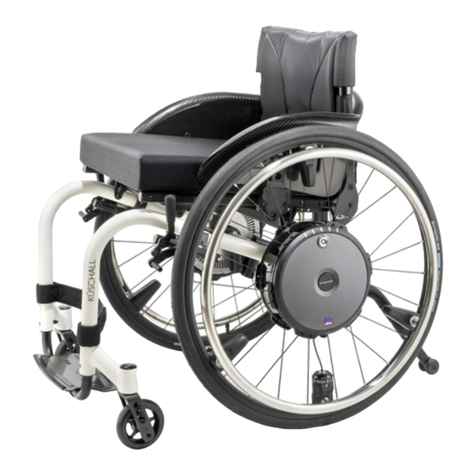Travel Buggy DASH User manual

Ultra Lite Power Wheelchair
2nd Generation
by Travel Buggy
DASH

TABLE OF CONTENTS
NOTICES 3
SAFETY INFORMATION 4
BATTERY SAFETY INFORMATION 5
SPECIFICATIONS 7
UNBOXING 9
UNFOLDING 10
FOLDING 11
SETUP 12
CONTROLLER 14
FREE WHEEL MODE 15
TRANSPORTING 16
BATTERY MAINTENANCE 18
CHARGING 20
MAINTENANCE,CARE,
TROUBLESHOOTING 22
LIMITED WARRANTY 23
CONTACT & SUPPORT 24
2
CAUTION: Read all precautions and instructions in this manual before using this equipment.
Improper use or maintenance can void the warranty. Keep this manual for future reference.

NOTICES
Thank you for choosing DASH Ultra Lite by Travel
Buggy, a convenient to use and foldable power
chair.
It is important to read through this manual before
operating your DASH Ultra Lite to become familiar
with its features as well as its limitations and
safety information
You will find the operation and care of your DASH
Ultra Lite very simple and easy, but should you
have any questions please contact Travel Buggy
OUR CUSTOMER HOTLINE
1.888.56.BUGGY (Canada)
1.855.56.BUGGY (USA)
EMAIL
DISCLAIMER:
The notes, warnings, and cautions contained within the manual and marked by the
triangular Caution Symbol should be given special care. Users should also pay
special attention to information marked in this manual beginning with NOTICE.
Travel Buggy, its affiliates and partners cannot be held responsible for personal injury or
property damage resulting from the unsafe or improper operation or maintenance of the
DASH Ultra Lite Power Wheelchair.
As part of our ongoing product improvement initiative, Travel Buggy reserves the right
to change specifications and design without notice. As a result, there may be minor
differences between your DASH Ultra Lite and the photos, illustrations and instructions in
this manual.
3

SAFETY INFORMATION
• DO make certain that the seat is in a
locked position when you are operating
your DASH Ultra Lite
• DO reduce your DASH’s speed when you
are driving around a corner
• DO proceed with caution as you
approach the downgrade of a ramp or
other incline and when driving near a
raised surface or unprotected ledges
and drop offs (curbs, porches, stairs,
etc.)
• DO avoid exposure to rain, snow, ice, salt,
or standing water whenever possible
• DO maintain and store in a clean and
dry condition
• DO keep your hands away from the tires
when driving. Be aware that loose fitting
clothing can become caught in drive
tires
• DO keep tools and other metal objects
away from battery terminals. Contact
with tools can cause electrical shock
• DO follow the recommended weight
capacity (265 lbs / 120 kg)
• DO follow the recommended incline
slope rating (9 degrees / 15.9%)
• DO check the battery charge to ensure
there is enough charge to get to your
destination before using.
• DO ensure your DASH Ultra Lite’s power is
OFF when entering and exiting the power
wheelchair
• DO NOT drive your DASH Ultra Lite across
the side of a hill or diagonally up or
down a hill, and do not stop (if possible)
while driving up or down an incline
• DO NOT operate your new DASH Ultra
Lite for the first time without completely
reading and understanding the owner’s
manual
• DO NOT carry additional passengers on
your DASH Ultra Lite
• DO NOT use your DASH Ultra Lite as a
seat in a moving vehicle
• DO NOT allow unsupervised children to
play near the power wheelchair
• DO NOT operate your DASH while under
the influence of alcohol, as this may
impair your ability to drive safely
• DO NOT sit in the DASH while in a moving
vehicle, an accident or sudden stop may
cause you to be thrown from the power
wheelchair
• ALL servicing must be performed by
qualified personnel only. Unauthorized
modifications to power wheelchair,
its power system or its control system
may compromise the performance
and safety of the system. UNDER NO
CIRCUMSTANCES should you attempt
any repair or service that is not covered
in this manual.
• ALWAYS ensure all safety warning labels
are in place and legible.
4
WARNING: The operator should read all of the warnings signs and instructions here and on the power wheelchair
before use.
WARNING: You should not operate your power chair on public streets and roadways. Be aware that it may be difficult
for traffic to see you when you are seated on your power wheelchair. Obey all local pedestrian traffic rules. Wait until
your path is clear of traffic, and then proceed with extreme caution.

BATTERY SAFETY INFORMATION
WHEN USING THE BATTERY
1. Lithium-ion battery packs may get hot,
explode or ignite and cause serious
injury if exposed to abuse conditions. Be
sure to follow the safety warnings listed
below:
• DO NOT place the battery near fire or
heat the battery
• DO NOT install the battery backwards
so the polarity is reversed
• DO NOT connect the positive and
negative terminal of the battery to
each other with any metal object
(such as a wire)
• DO NOT carry or store the battery
together with necklaces, hairpins, or
other metal objects
• DO NOT pierce the battery with nails
strike the battery with a hammer,
step on the battery or otherwise
subject it to strong impacts or shocks
• DO NO solder directly onto the
battery
• DO NOT expose battery to water or
salt water, or allow the battery to get
wet
2. DO NOT disassemble or modify the
battery. The battery contains safety and
protection devices, which if damaged,
may cause the battery to generate heat,
explode or ignite
3. DO NOT place the battery in or near fire,
on stoves or other high temperature
locations. Do not place the battery in
direct sunlight, or use or store battery
inside cars in hot weather. Doing so may
cause the battery to generate heat,
explode or ignite. Using the battery in
this manner may also result in a loss
of performance and a shortened life
expectancy.
4. If the device is to be used by children, the
caregiver should explain the contents
of this document to the children and
provide adequate supervision to ensure
the device is being used appropriately
5. When the battery is worn out, insulate
the terminals with adhesive tape or
similar materials before disposal
6. Immediately discontinue use of the
battery if, while using, charging or
storing the battery, the battery emits an
unusual smell, feels hot, changes color,
or shape, or appears abnormal in any
way. Contact the Fire Department if any
of these problems are observed
7. DO NOT place battery in microwave over,
high pressure containers or on induction
cookware
5

BATTERY SAFETY INFORMATION
CHARGING PRECAUTIONS
1. BE SURE to follow the warnings listed
below while charging the battery.
Failure to do so may cause the battery
to become hot, explode or ignite and
cause serious injury.
• When charging the battery, ONLY USE
THE SPECIFIED CHARGER PROVIDED
WITH THE PRODUCT
• DO NOT attach the battery to a
power supply plug or directly to a
car’s cigarette lighter
• DO NOT place the battery in or near
fire, or in direct sunlight. Heating
the battery can damage the safety
circuitry, which can cause additional
heating, rupture or ignition of the
battery
2. DO NOT continue charging the battery
if it does not recharge in the timelines
specified in the operating manual
3. THE TEMPERATURE range over which a
battery can be charged is 0°C to 45°C
(32°F to 113°F). Charging the battery at
temperatures outside of that range may
cause severe damage to the battery or
reduce battery life expectancy
• Always protect battery from
freezing temperatures and never
charge a frozen battery. This will
damage the battery and may
cause personal injury. Attempting
to charge a battery in freezing
conditions does not prevent a
battery from freezing.
WHEN DISCHARGING THE BATTERY
1. DO NOT discharge the battery using any
other device except for the specified
device. When the battery is used in
devices other than the specified device,
it may damage the battery or reduce
its life expectancy. If the device causes
abnormal current flow, it may cause the
battery to become hot, explode or ignite
and cause serious injury.
2. THE TEMPERATURE range over which the
battery can be discharged is -20°C to
60°C (-4°F to 140°F). Use of the battery
outside this temperature range may
damage the performance of the battery
or may reduce its life expectancy.
6

7
SPECIFICATIONS
EASY TO USE CONTROLLER
LITHIUM BATTERY
BREATHABLE CUSHION
MANUAL PUSH
HANDLE
LIFT-UP ARM RESTS
FOOT PEDAL
OVERALL HEIGHT 34"
OVERALL LENGTH 38" OVERALL WIDTH 24"
BACK REST 15"
SEAT DEPTH 16" SEATING WIDTH 18.5"
12 INCH REAR WHEEL
8 INCH FRONT
WHEEL
170 WATT BRUSHLESS
MOTORS (DUAL)
FLOOR TO SEAT 20"

PERFORMANCESPECIFICATIONS
DRIVING RANGE: 9.5 MI / 15 KM
MAXIMUM SPEED: 4.5 MPH / 7 KPH
DRIVE SYSTEM: TWO MOTOR DRIVE
SYSTEM
MOTOR TYPE: 170 WATT BRUSHLESS
INCLINE CAPABILITY: 9° / 15.9%
TURNING RADIUS: 35”
STOPPING DISTANCE: 5 FT (AT FULL
SPEED)
OBSTACLE CLEARANCE: 1.6”
BRAKING SYSTEM: ELECTROMAGNETIC
MAX WEIGHT CAPACITY: 265 LBS
DIMENSIONAL SPECIFICATIONS
UNFOLDED DIMENSIONS:
38"L X 24"W X 34"H
CHAIR GROSS WEIGHT: 43 LBS
CHAIR NET WEIGHT: 39 LBS (NO
BATTERY)
SEAT CUSHION SIZE: 17" (W) X 16" (D)
FOLDED DIMENSIONS:
30"L X 24"W X 13.5"H
SEATING WIDTH: STANDARD 18.5”
FRONT WHEEL DIAMETER: 8”
REAR WHEEL DIAMETER: 12”
FLOOR TO SEAT HEIGHT: 20”
BACK SUPPORT HEIGHT: 15”
OTHER SPECIFICATIONS
BATTERY TYPE: LITHIUM ION 24V/10AH
BATTERY PROVIDED: ONE (1)
BATTERY WATT HOUR: 240 WH
(AIRLINE APPROVED)
BATTERY CHARGE CYCLES: ~1000
TIRES: NON-PUNCTURE
CHARGING TIME: 4 TO 6 HOURS
CHARGER INPUT: 100-240V,
50/60HZ (INTERNATIONAL)
CHARGER OUTPUT: 29.4V 2.0A
LAP BELT: PROVIDED
HORN: BUILT-IN
SPECIFICATIONS
8

UNBOXING
• To remove the power chair, orientate
the box such that when it is laid down
on the ground the padded bar is at the
top and the footplate is at the bottom
• Grab the bar at the top and begin to
pull your Travel Buggy out horizontally
parallel with the ground.
BOTTOM
TOP
• Locate the components provided with your power wheelchair
BATTERY CHARGER
JOYSTICK CONTROLLER LITHIUM BATTERY
LAP BELT
TOOLS
9
NOTICE: Lithium battery is installed in the equipment when shipped.

• Lay DASH Ultra Lite on a flat on the
ground as illustrated above
• Hold the top bar and pull up the chair
while pressing the edge of the seat to
open similar to a lawn chair.
UNFOLDING
• Continue to unfold the power chair until
it is in fully expanded seating position.
• Ensure the chair is fully extended and
locked into the seating position.
10
NOTICE: Failure to fully extend the power chair into its locked position may result in injury while driving.

FOLDING
• Pull the seat back lock mechanism to
release the chair for folding
• Continue the folding process by
holding one hand beneath the seat
frame and another on the top bar
(image 2), similar to a lawn chair
• Fold the footrest into the power chair
before continuing the folding process
• The power chair is now completely
folded. DASH Ultra Lite can also be
folded on to its rear wheels and stands
on its own for greater convenience.
11

SETUP
• Locate the joystick controller.
• Slide the joystick controller into the arm rest tube (image 1). The length of the joystick controller
can be adjusted for comfort before or after secured
• Tighten the screw underneath the armrest once the joystick is inserted to the desired length
(image 2)
• Align the arrows of the joystick connection cables and press them together to plug the joystick
controller in. Rotate the coupling over the connection point to secure the connection point (im-
age 3)
1 32
12
NOTICE: Make sure the battery is connected to the system or the chair will not work (image 3)

2
SETUP
• Before sitting in the Power Chair, be sure the power button
is OFF and the rear brake levers are in the DOWN (locked)
position
• DASH Ultra Lite offers the user 2 optional entry alternatives,
direct front entry or side entry
• If you prefer a front entry, we recommend flipping up the
foot plate to create an easier sitting experience
• DO NOT step on the footplate when entering or exiting the
DASH Ultra Lite as it may cause the power chair to move in
an unsafe manner
• Joystick can be positioned on left or right arm rest
• To change joystick position, first remove the joystick by
performing the opposite sequence of the steps above
• Move the power cable to the opposite side and re-fasten
with plastic ties, be sure the cable is not interfering with
the folding or movement of the power chair
• Connect the joystick
LEFT JOYSTICK
RIGHT JOYSTICK
1
To enter from the side of
the chair, press down on
the arm rest release button
as shown in image 1. Raise
the arm rest back and
away. When seated, lower
arm rest back into position
and ensure it is locked.
13

Press the GREEN button
to turn ON/OFF the power
chair
There are a total of 5 battery
power indicator lights: 3 Green,
1 Yellow and 1 Red. From right to
left the lights will disappear as
the battery drains indicating
the amount of charge
remaining. Recharge at any
point before the last Red light
disappears, indicating a fully
depleted battery.
CONTROLLER
• DASH Ultra Lite Power Chair has an easy to use 360 degree joystick controller featuring multiple
speeds and a battery life indicator
• Take some time in a safe, controlled environment to learn the operation of the controller, the
speed and the maneuverability of the DASH Ultra Lite
• Be sure to adjust the speed depending on your environment and while turning
• To slow down, slowly bring the joystick back toward the initial position.
• To stop, just bring the joystick back to the initial position
• Use extra care when you drive the DASH Ultra Lite in reverse
Press the button to
increase the speed
1-Light On 1.5 MPH
2-Lights On 2.25 MPH
3-Lights On 3 MPH
4-Lights On 3.75 MPH
All 5-Lights On 4.5 MPH
Press the button to
decrease the speed
INCREASE SPEED
SPEED CONTROL LIMITS
Speed Control
5-Speed
Control Lights Battery Indicator
Lights
Power ON/OFF
DECREASE SPEED
POWER ON/OFF
14
Press the button to
sound the horn
Horn

FREE WHEEL MODE
• In order to have a care giver push the
DASH Ultra Lite, it must be put in Free
Wheel mode
• This mode disengages the drive
mechanism to the wheels, making
them free to push manually
• To put the DASH Ultra Lite in Free Wheel
Mode, come to a full stop and turn OFF
the power on the controller.
• Push UP on the two red levers located
on each rear wheel as shown
• To re-engage the chair for POWER
mode, press the levers down.
FREE WHEEL/ MANUAL
MODE (UP)
LOCKED/ POWER
MODE (DOWN)
15
NOTICE: If the chair beeps and won't move, there is a good chance the motors remain in FREE WHEEL mode. Refer to the
TROUBLE SHOOTING section for more details.

TRANSPORTING
• Turn OFF your DASH Ultra Lite power wheelchair
• Unlock the chair by pulling on the frame latch (image 1) while simultaneously beginning the
folding process
• Continue the folding process by holding one hand beneath the seat frame and another on the
top bar (image 2), similar to a lawn chair
• Once folded, the power chair can balance on its anti-tip wheels (image 3)
• Finally, the footrest can be used to pull the DASH Ultra Lite easily (image 4) or it can roll in the
folded position similar to a suitcase.
1
34
2
16

TRANSPORTING
• To load the DASH Ultra Lite power chair
into the back of a vehicle for transport
we recommend utilizing the back of the
vehicle as leverage
• Position the power chair against the
car as indicated in Image 1 (Note:
we recommend a blanket to reduce
scratching of the vehicle)
• Grasp the rear wheels (Image 2)
• Lift against the back of the vehicle,
leveraging the power wheelchair into
the trunk of the vehicle (Image 3)
• Push the DASH Ultra Lite into the desired
position within the vehicle (Image 4)
1 2
43
17
WARNING: Never transport the DASH Ultra Lite in a tie down system, as the DASH Ultra Lite is not compatible with them.
Never sit in the DASH Ultra Lite and be transported in a moving vehicle. Do not place the folded DASH Ultra Lite in the
front seat with the driver where it could move or slide.

BATTERY MAINTENANCE
Lithium-Ion rechargeable battery require
routine maintenance and care in their
use and handling. Read and follow the
guidelines in this document to safely
use Lithium-Ion battery and achieve the
maximum battery life span.
OVERVIEW
Do not leave battery unused for extended
periods of time, either in the product or in
storage. When a battery has been unused
for 6 months, check the charge status
and charge or dispose of the battery as
appropriate.
The typical estimated life of a Lithium-Ion
battery is about three years or ~1000 charge
cycles, whichever occurs first. One charge
cycle is a period of use from fully charged,
to fully discharged, and fully recharged
again. Use a three-year life expectancy for
battery that do not run through complete
charge cycles.
Rechargeable Lithium-Ion battery have
a limited life and will gradually lose their
capacity to hold a charge. This loss of
capacity (aging) is irreversible. As the
battery loses capacity, the length of time it
will power the product (run time) decreases.
Lithium-Ion battery continue to slowly
discharge (self-discharge) when not in
use or while in storage. Routinely check the
battery’s charge status.
Use only the provided battery(s) in your
product.
BATTERY MAINTENANCE
Observe and note the run time that a new
fully-charged battery provides for powering
your product. Use this new battery run
time as a basis to compare run times for
older battery. The run time of your battery
will vary depending on the product’s
configuration and the applications that you
run.
Routinely check the battery’s charge status.
Carefully monitor battery that are
approaching the end of their estimated life.
Consider replacing the battery with a
new one if you note either of the following
conditions:
• The battery run time drops below about
80% of the original run time.
• The battery charge time increases
significantly.
If a battery is stored or otherwise unused
for an extended period, be sure to follow
the storage instructions in this document. If
you do not follow the instructions, and the
battery has no charge remaining when you
check it, consider it to be damaged. Do not
attempt to recharge it or to use it. Replace it
with a new battery.
CHARGING
Always follow the charging instructions
provided with your product. Refer to your
product’s user manual and/or online help
for detailed information about charging its
battery.
Use only the provided charger to charge
your battery(s).
18

BATTERY MAINTENANCE
STORAGE
• Charge or discharge the battery to
approximately 50% of capacity before
storage.
• Charge the battery to approximately
50% of capacity at least once every six
months.
• Remove the battery and store it
separately from the product.
• Store the battery at temperatures
between 5 °C and 20 °C (41 °F and 68
°F).
HANDLING PRECAUTIONS
• Do not disassemble, crush, or puncture
a battery.
• Do not short the external contacts on a
battery.
• Do not expose a battery to fire or water.
• Do not expose a battery to
temperatures above 60 °C (140 °F).
• Keep the battery away from children.
• Avoid exposing the battery to excessive
shock or vibration.
• Do not use a damaged battery.
• If a battery pack has leaking fluids, do
not touch any fluids.
• Dispose of a leaking battery pack
(see Disposal and Recycling in this
document).
• In case of eye contact with fluid, do
not rub eyes. Immediately flush eyes
thoroughly with water for at least 15
minutes, lifting upper and lower lids,
until no evidence of the fluid remains.
Seek medical attention.
• Immediately discontinue use of the
battery if, while using, charging or
storing the battery, the battery emits an
unusual smell, feels hot, changes color,
or shape, or appears abnormal in any
way. Contact the Fire Department if any
of these problems are observed
TRANSPORTATION
• Always check all applicable local,
national, and international regulations
before transporting a Lithium-Ion
battery.
• Transporting an end-of-life, damaged,
or recalled battery may, in certain
cases, be specifically limited or
prohibited.
DISPOSAL AND RECYCLING
• Lithium-Ion battery are subject to
disposal and recycling regulations that
vary by country and region. Always
check and follow your applicable
regulations before disposing of any
battery. Contact Rechargeable Battery
Recycling Corporation (www.rbrc.org)
for U.S.A. and Canada, or your local
battery recycling organization.
• Many countries prohibit the disposal
of waste electronic equipment in
standard waste receptacles.
• Place only discharged battery in a
battery collection container. Use
electrical tape or other approved
covering over the battery connection
points to prevent short circuits.
19
NOTE: The battery self-discharges during storage. Higher temperatures (above 20 °C or 68 °F) reduce the battery
storage life.

CHARGING
• Upon unboxing and set up, first check
the charge of the battery before
immediately assuming there is a
requirement to re-charge the battery
• Avoid unnecessary re-charging to
maintain the life of your battery
ONBOARD CHARGING (PREFERRED
METHOD)
• Turn OFF the power to the DASH Ultra Lite
• Connect the charger (XLR male) to the
controller port (XLR female)
• Connect the input plug of charger with
your local power source
• Check on the charger brick that the light
is yellow (charging)
OFFBOARD CHARGING
• Turn OFF the power to the DASH Ultra Lite
• To remove the battery, first pull
on the locking pin (image 1) while
simultaneously pulling the battery out
from below the power chair.
• Connect the charger (XLR male) to the
battery charging port (XLR female)
• Connect the input plug of charger with
your local power source.
• Please ensure the charger and battery
are on a flat surface and keep in a well
ventilated area
• Once charging is complete, remove the
power cord and ensure that the battery
is re-inserted correctly back into the
power chair prior to driving. The power
port (male) located at the back of the
battery needs to fit squarely into the
battery mount located below the power
chair.
20
WARNING: TO REDUCE THE RISK OF INJURY, CHARGE LITHIUM-ION PROVIDED BATTERY ONLY WITH PROVIDED LITHIUM-ION
BATTERY CHARGER. Other types of chargers may cause the battery to generate heat, explode or ignite potentially
causing personal injury or damage.
Offboard Charging
Onboard Charging
BATTERY
CHARGE PORT
(XLR)
PHONE CHARGER PORT
(USB-A)
Table of contents
Languages:
Other Travel Buggy Wheelchair manuals
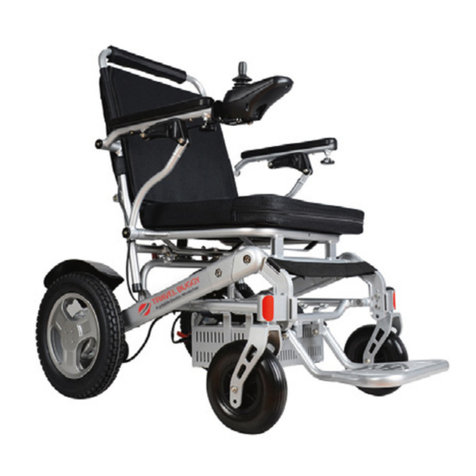
Travel Buggy
Travel Buggy CITY PLUS User manual
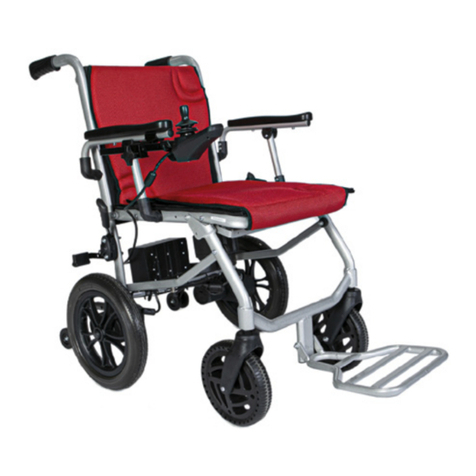
Travel Buggy
Travel Buggy DASH Ultra Lite Power User manual

Travel Buggy
Travel Buggy VISTA User manual

Travel Buggy
Travel Buggy CITY User manual

Travel Buggy
Travel Buggy CITY 2 PLUS User manual

Travel Buggy
Travel Buggy DASH Ultra Lite Power User manual

Travel Buggy
Travel Buggy CITY 2 PLUS User manual

